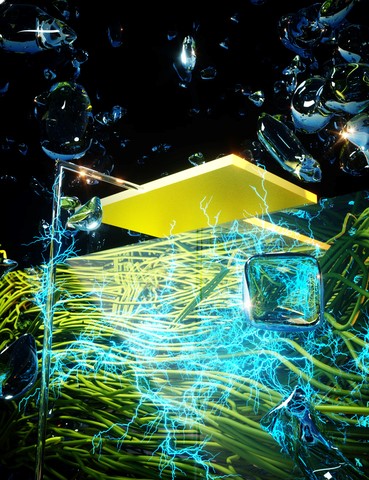Powering the Future: UMass Amherst Engineers Unleash 24/7 Clean Energy from Thin Air!
Engineers at the University of Massachusetts Amherst have made a groundbreaking discovery in the field of clean energy. Their recent research, published in the esteemed journal Advanced Materials, reveals that by incorporating nanopores smaller than 100 nanometers in diameter, virtually any material can be transformed into a continuous electricity-harvesting device utilizing the ambient humidity in the air. This remarkable breakthrough paves the way for a limitless and sustainable energy source, propelling us towards a greener future. [1]

Figure 1. Nanopores. (Credit: Derek Lovley/Ella Maru Studio)
Figure 1 shows Nanopores are the secret to making electricity from thin air. These nanopores allow water molecules to pass through and create a charge imbalance, essentially forming a battery that runs as long as there is humidity. “This is very exciting,” says Xiaomeng Liu, a graduate student in electrical and computer engineering in UMass Amherst’s College of Engineering and the paper’s lead author. “We are opening up a wide door for harvesting clean electricity from thin air.” [1]
“The air contains an enormous amount of electricity,” says Jun Yao, assistant professor of electrical and computer engineering in the College of Engineering at UMass Amherst, and the paper’s senior author. “Think of a cloud, which is nothing more than a mass of water droplets. Each of those droplets contains a charge, and when conditions are right, the cloud can produce a lightning bolt—but we don’t know how to reliably capture electricity from lightning. What we’ve done is to create a human-built, small-scale cloud that produces electricity for us predictably and continuously so that we can harvest it.” [1]
The core principle behind the creation of the man-made cloud revolves around what Yao and his team refer to as the "universal Air-gen effect." This breakthrough builds upon the prior research conducted by Yao and co-author Derek Lovley, a distinguished professor of Microbiology at UMass Amherst. In their earlier work from 2020, they demonstrated the continuous extraction of electricity from the air by employing a unique material composed of protein nanowires derived from the bacterium Geobacter sulfurreducens. [1]
“What we realized after making the Geobacter discovery,” says Yao, “is that the ability to generate electricity from the air—what we then called the ‘Air-gen effect’—turns out to be generic: literally any kind of material can harvest electricity from air, as long as it has a certain property.” [1]
That property? “It needs to have holes smaller than 100 nanometers (nm), or less than a thousandth of the width of a human hair.” [1]
This phenomenon can be attributed to a crucial factor called the "mean free path," which represents the distance traveled by individual molecules of a substance, such as water in the air, before colliding with another molecule of the same substance. In the case of airborne water molecules, their mean free path measures approximately 100 nm. [1]
Yao and his research team recognized the potential of leveraging this characteristic and devised an innovative approach to generate electricity. They conceived an electricity harvester constructed with a thin layer of material containing nanopores smaller than 100 nm, enabling the passage of water molecules from the upper to the lower section of the material. However, due to the minuscule size of each pore, the water molecules encounter the edges of the pores while traversing the thin layer. Consequently, the upper region of the material experiences a higher influx of water molecules carrying an electric charge compared to the lower region. This disparity in charge accumulation resembles the charge imbalance observed in a cloud. As a result, an effective battery-like system is established, capable of operating continuously as long as there is any level of humidity present in the surrounding air. [1]
“The idea is simple,” says Yao, “but it’s never been discovered before, and it opens all kinds of possibilities.” The harvester could be designed from literally all kinds of material, offering broad choices for cost-effective and environment-adaptable fabrications. “You could image harvesters made of one kind of material for rainforest environments, and another for more arid regions.” [1]
And since humidity is ever-present, the harvester would run 24/7, rain or shine, at night and whether or not the wind blows, which solves one of the major problems of technologies like wind or solar, which only work under certain conditions. [1]
The unique advantage of the Air-gen device lies in its ability to leverage the three-dimensional diffusion of air humidity. With the device's thinness measuring only a fraction of a human hair's width, it becomes feasible to stack numerous devices on top of each other. This stacking capability enables efficient scaling of energy production without requiring a larger physical footprint. By harnessing this potential, an array of Air-gen devices can generate kilowatt-level power, catering to the energy demands of general electrical utility usage. [1]
“Imagine a future world in which clean electricity is available anywhere you go,” says Yao. “The generic Air-gen effect means that this future world can become a reality.” [1]
This research was supported by the National Science Foundation, Sony Group, Link Foundation, and the Institute for Applied Life Sciences (IALS) at UMass Amherst, which combines deep and interdisciplinary expertise from 29 departments on the UMass Amherst campus to translate fundamental research into innovations that benefit human health and well-being. [1]
Source: UMass Amherst
References:
- https://www.umass.edu/news/article/engineers-umass-amherst-harvest-abundant-clean-energy-thin-air-247
- https://newatlas.com/energy/lightning-like-energy-from-air/
- https://scitechdaily.com/clean-energy-24-7-engineers-use-nanotechnology-to-harvest-electricity-from-thin-air/
Cite this article:
Hana M (2023), Powering the Future: UMass Amherst Engineers Unleash 24/7 Clean Energy from Thin Air!, AnaTechmaz, pp.441

